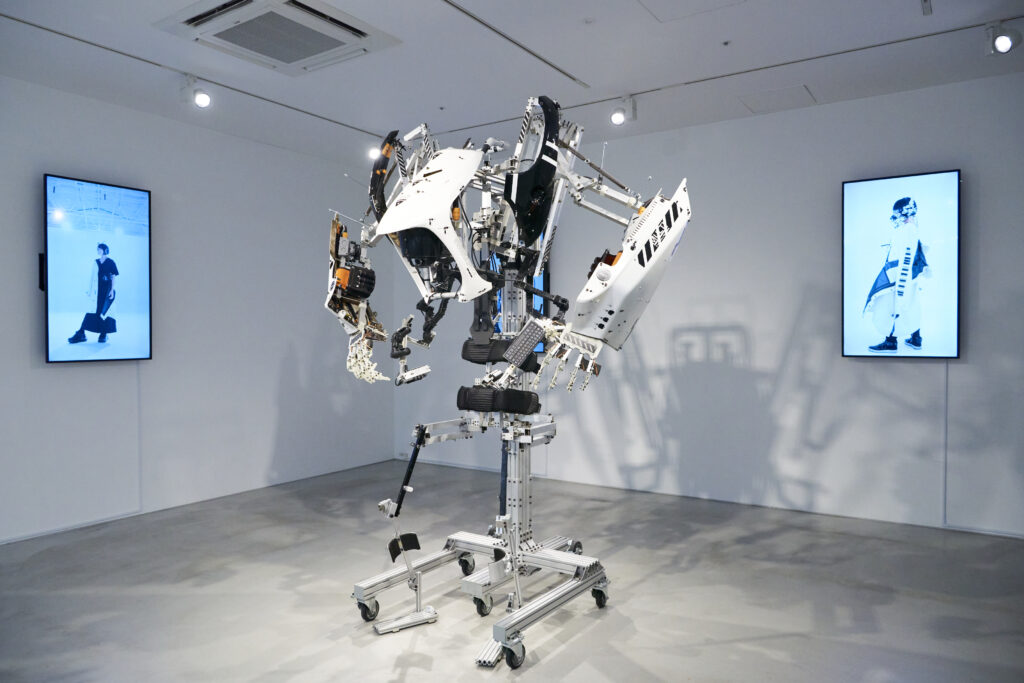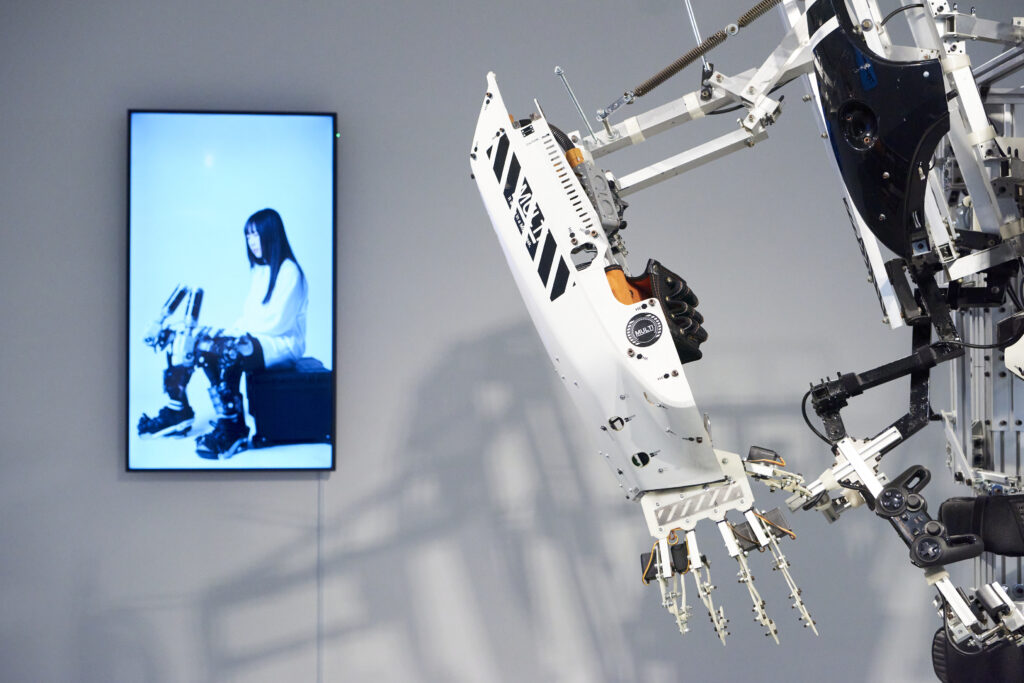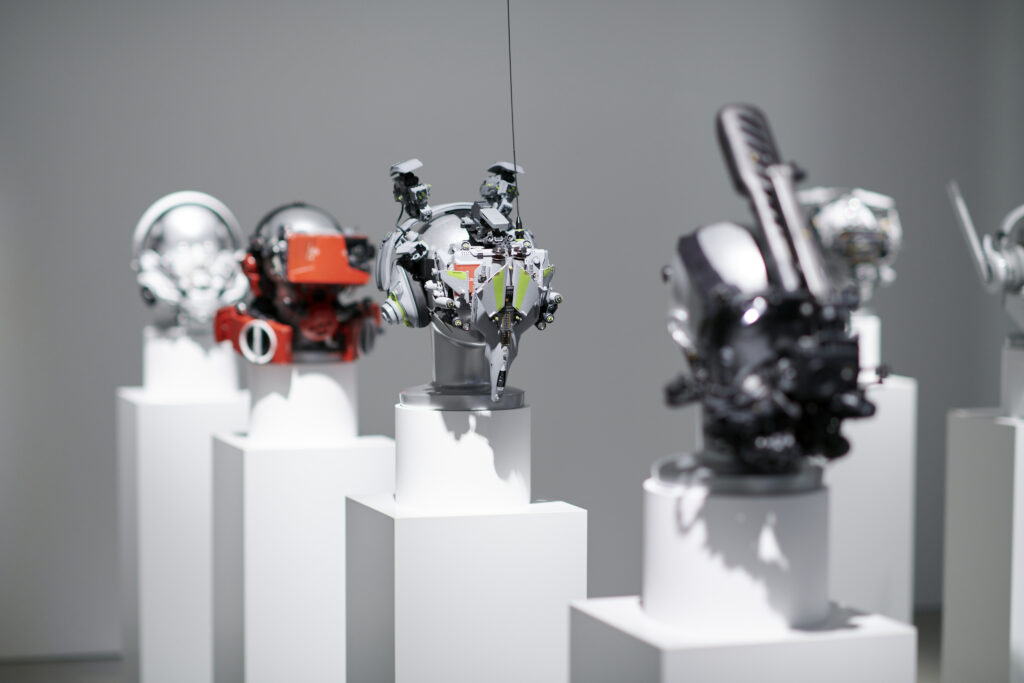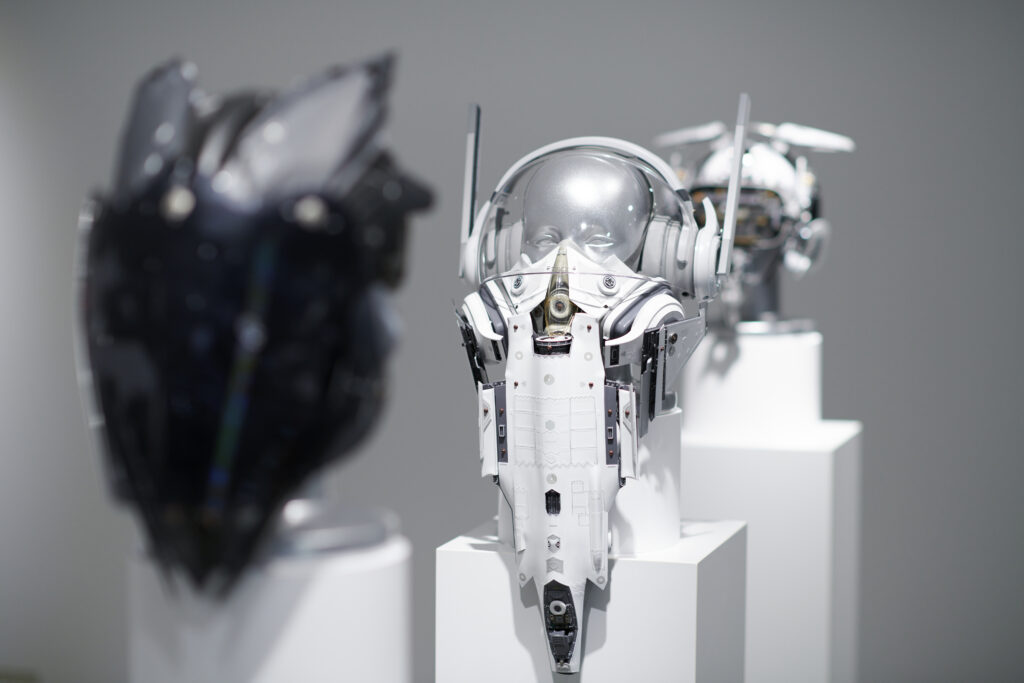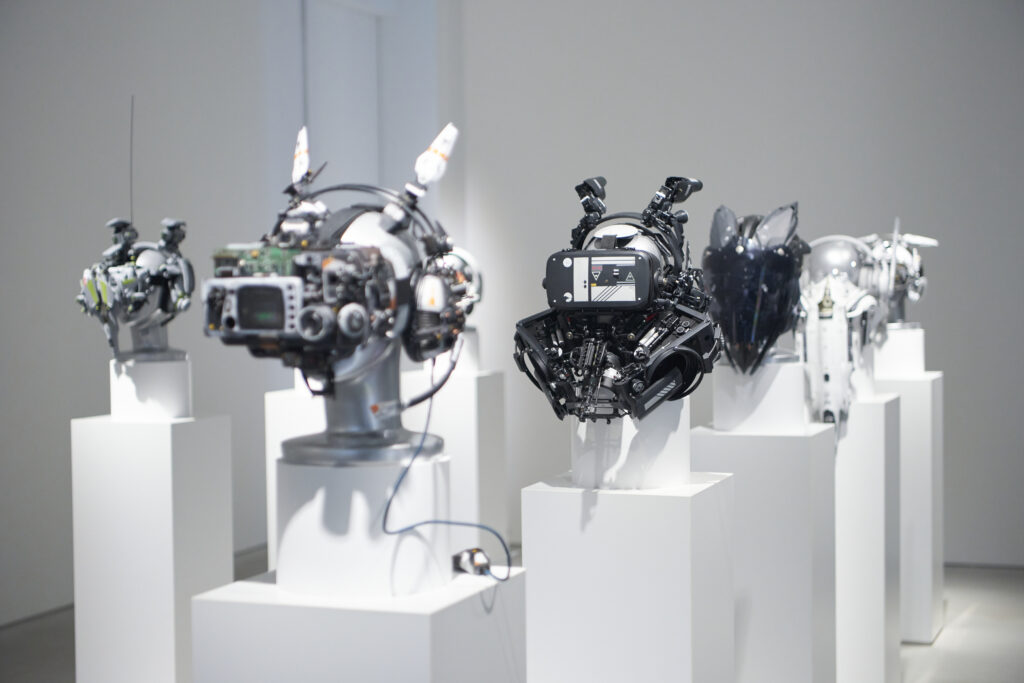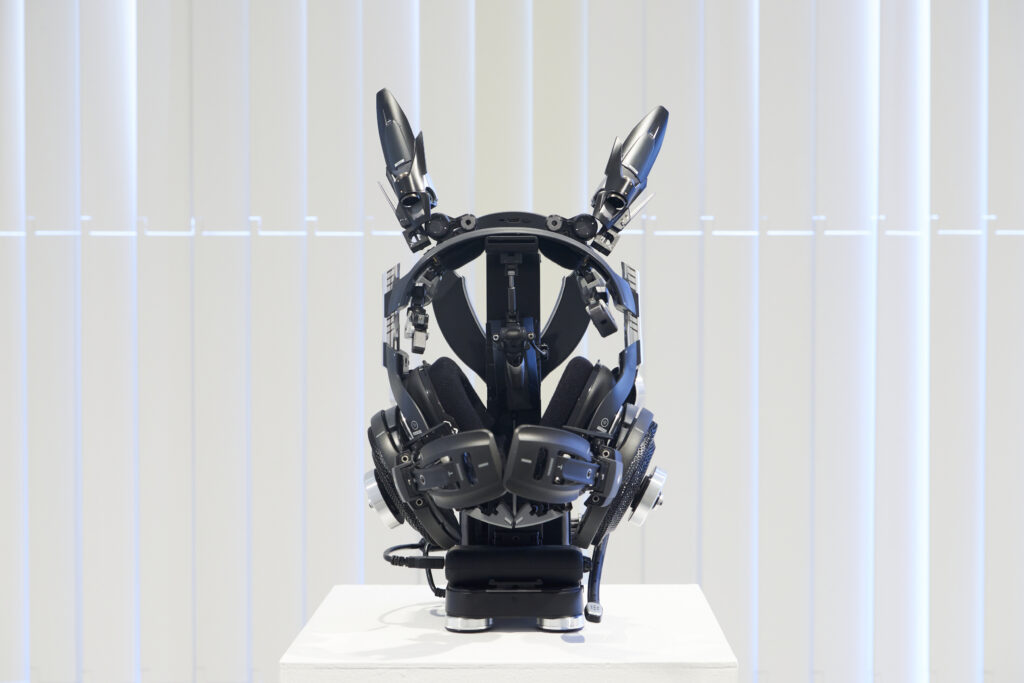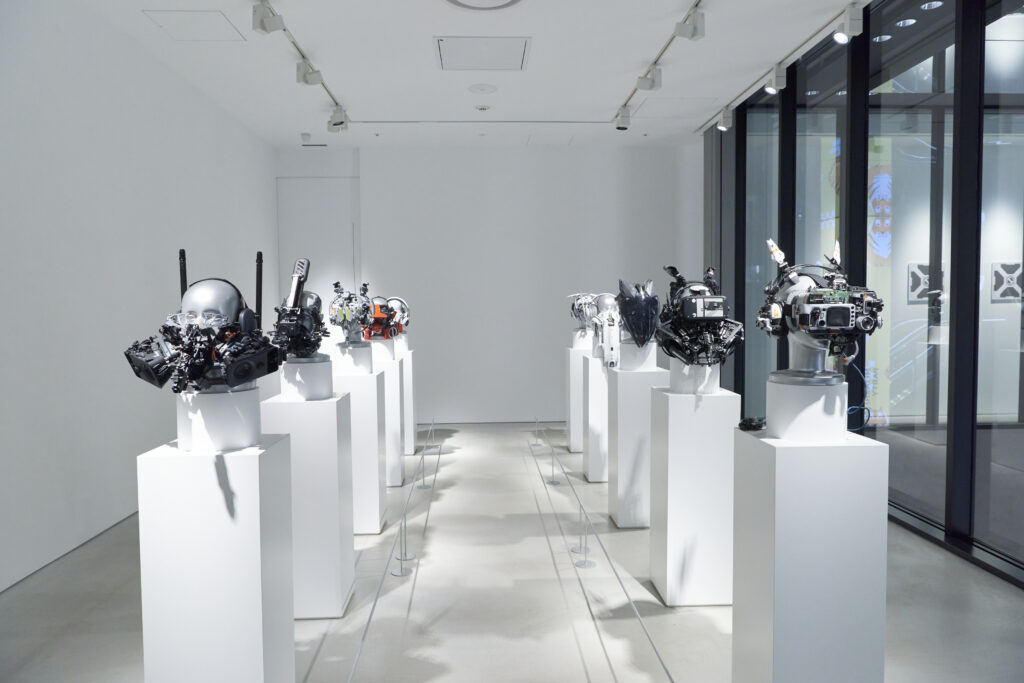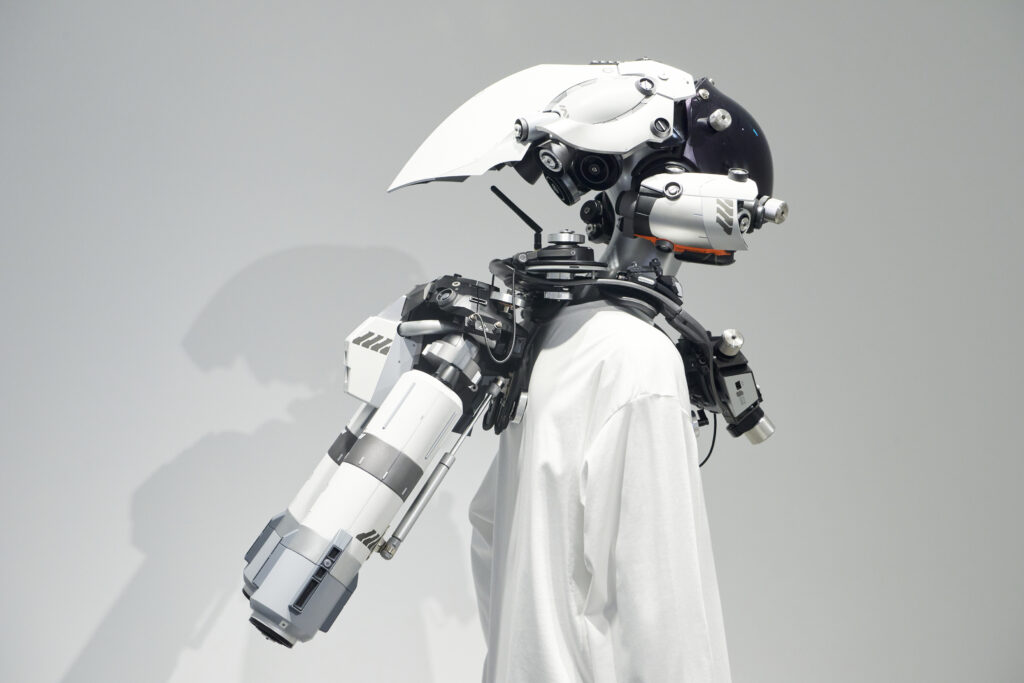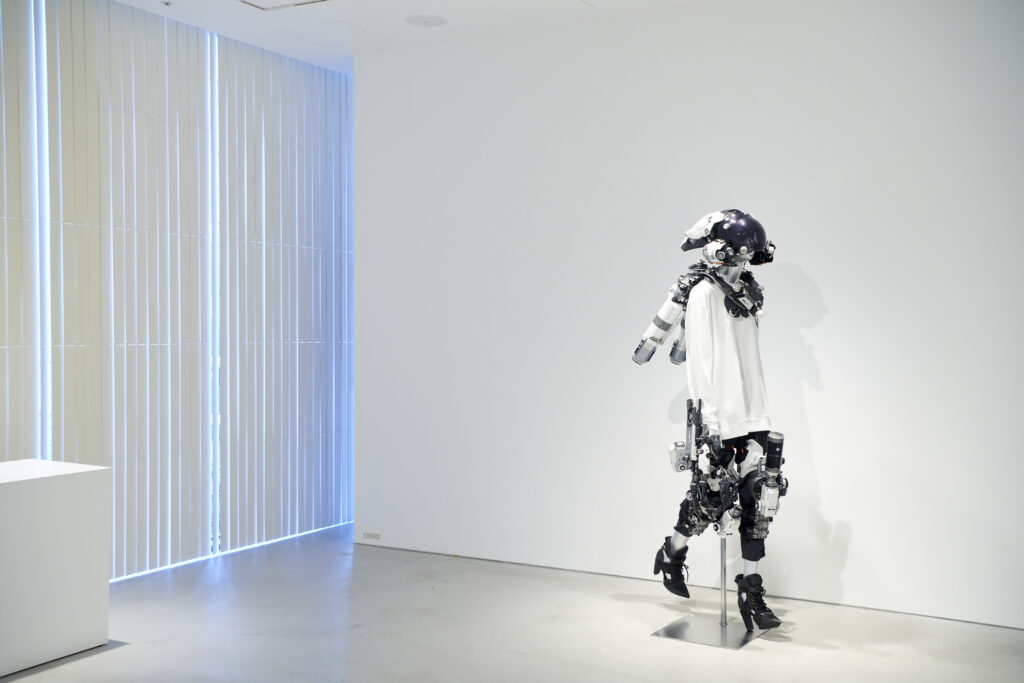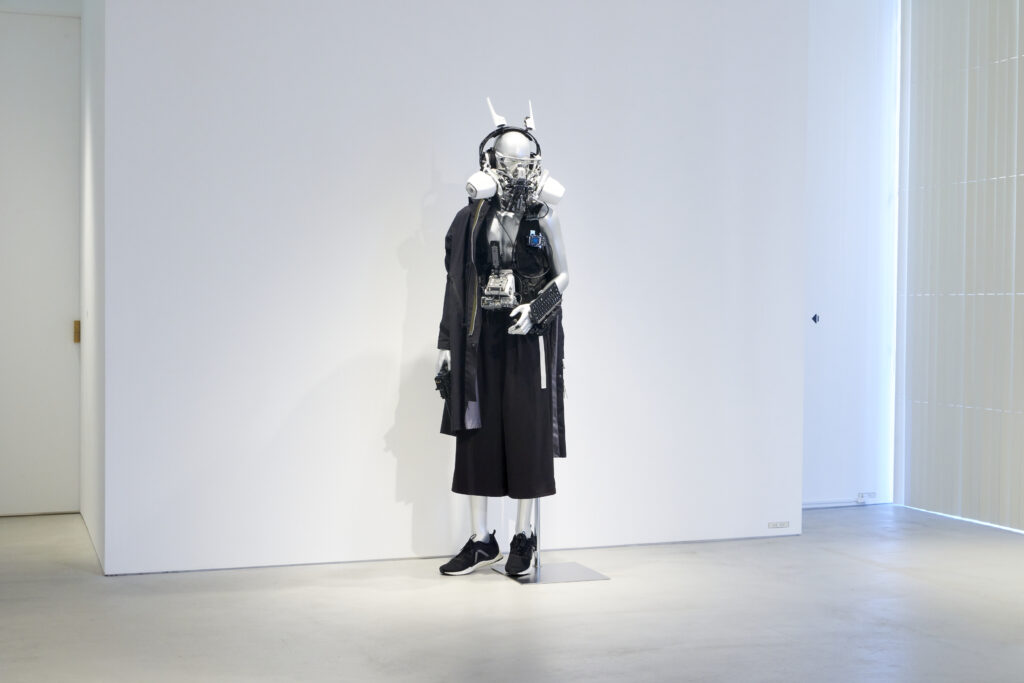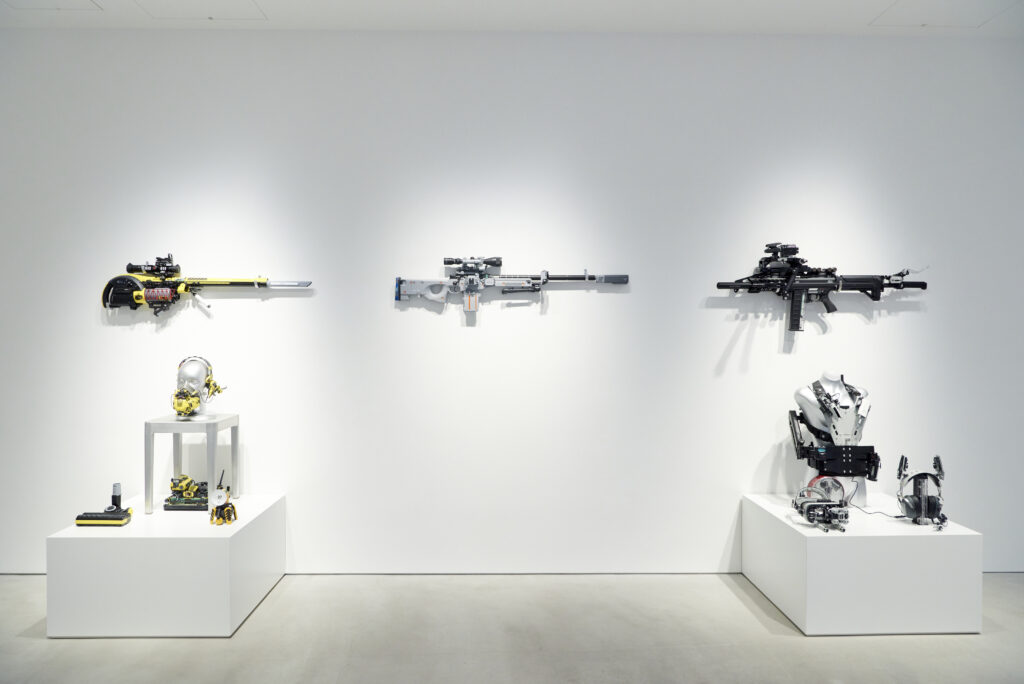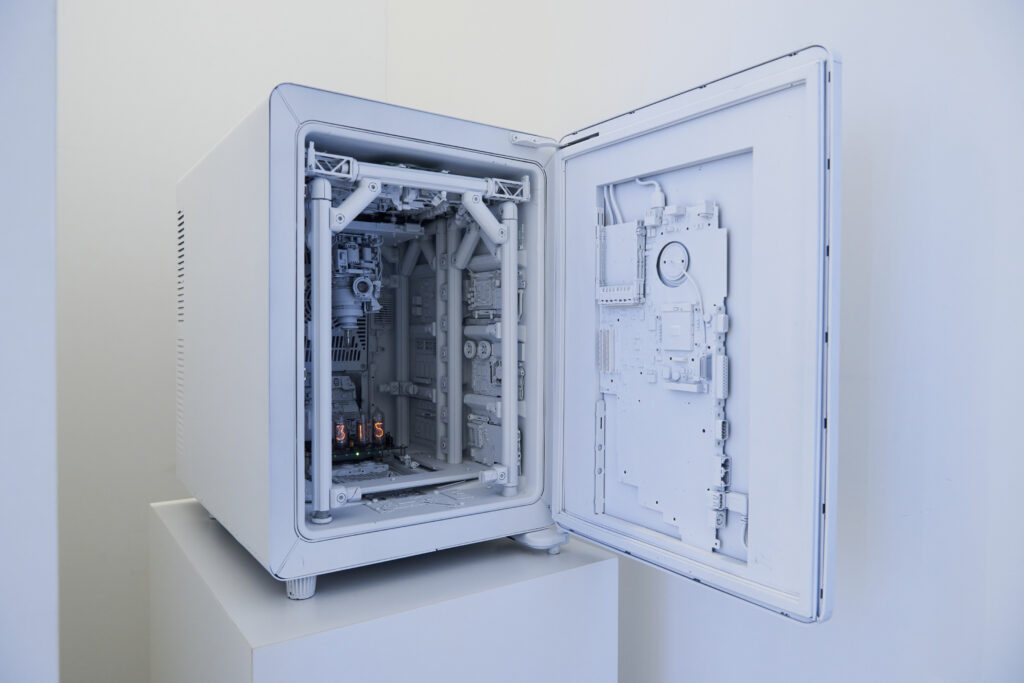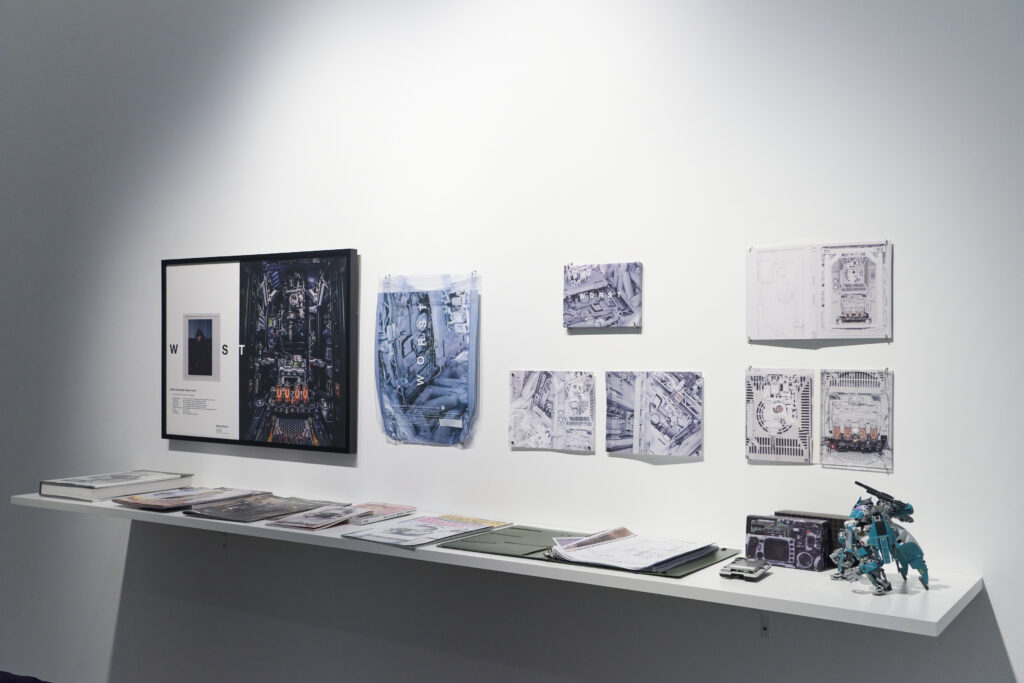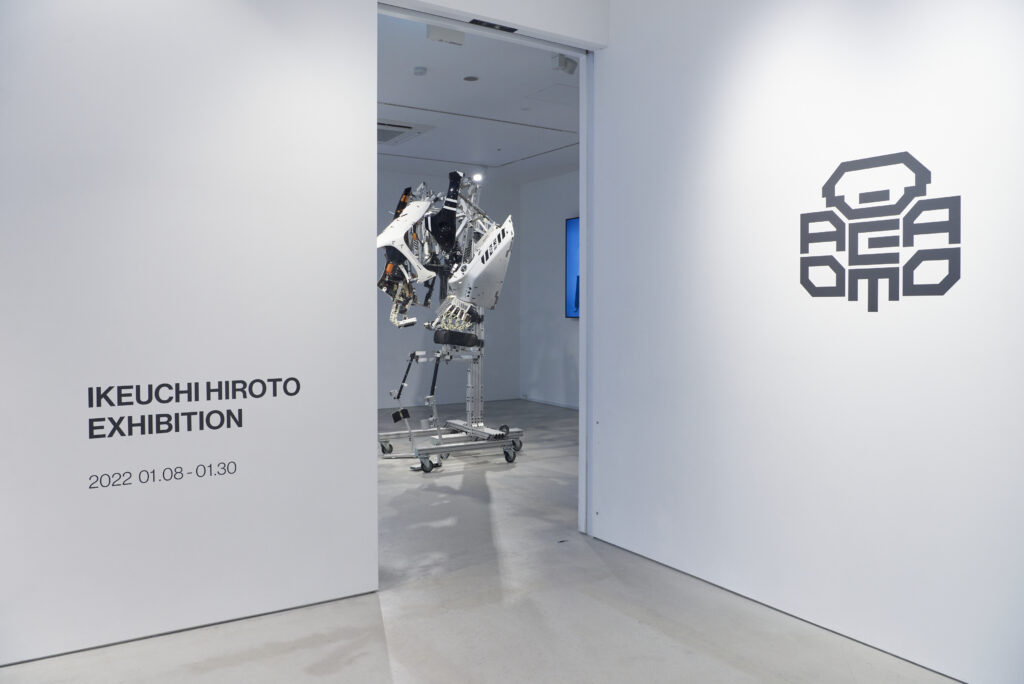Hiroto Ikeuchi is a plastic artist who’s gained worldwide attention for his artworks that combine ready-made plastic models and industrial parts. He worked with Balenciaga on their Spring 2022 campaign and has become a popular figure beyond the borders of art.
Ikeuchi’s currently holding his most extensive solo exhibition to date, “IKEUCHI HIROTO EXHIBITION,” at SAI Gallery in Shibuya until January 30. It features a conceptual space based around full-body suits created with the development and manufacturing team of the body-enhancing robot company, Skeletonics. Visitors can also experience new immense works created in collaboration with PROTOTYPE INC. Additionally, visitors can learn about the process and inspiration behind his artworks.
How did Ikeuchi come to create his current art style? What goes into his artworks? I sat down with him at his solo exhibition venue.
–How did you start creating art?
Hiroto Ikeuchi (Ikeuchi): It’s not like I liked making things as a child, and I wasn’t that good at studying either. I was what you might call a nerdy student. In high school, my art teacher told me about this art school. So, I enrolled in Tama Art University, where I began creating artworks. I made models all through university; that’s the origin of where I am today with creating my work.
–That’s surprising to hear. Did you have opportunities to make models as a child?
Ikeuchi: As a child, I wasn’t that interested in making models. The first time I made a model was at the end of my senior year of high school. I didn’t have anything to do after the university entrance exams when a friend recommended I do it. So, I gave it a shot.
–Do you remember the first plastic model you created?
Ikeuchi: It was a Gundam plastic model called Qubeley; part of the Master Grade series. I had always liked Mamoru Nagano’s manga The Five Star Stories, and I chose Qubeley because he designed it.
–Did you then begin creating mainly models at university?
Ikeuchi: I entered the Department of Information Design at Tama Art University, where I made some animations and two-dimensional works for assignments, which I wasn’t very good at. I didn’t hate drawing pictures, but I preferred three-dimensional things, so I spent most of my time creating models.
–I heard that a diorama you created when you graduated from university, which was composed of a computer and a model, inspired your current style of combining ready-made plastic models and industrial parts.
Ikeuchi: That’s right. After graduating from university, I made diorama art from roughly 2013 to 2015. Then I developed a style where I combined plastic models and industrial parts.
–Was there an impetus for this shift in your art style?
Ikeuchi: I wasn’t intent on changing my style deliberately. Nothing has fundamentally changed in terms of being influenced by everyday things and making pieces. In the past, that was the computer, but as time passed, that changed to Bluetooth headphones, VR, and such. I incorporate those things into my work.
–According to your press release, Star Wars, Zoids, and Gundam have influenced you. I can sense that influence in your art style.
Ikeuchi: The first episode of Star Wars came out when I was in elementary school. That’s when I started watching it. I also watched The Matrix as an elementary school student and was shocked. I watched Zoids when the anime version came out.
–When did you get into Gundam?
Ikeuchi: I got into Gundam late when I was a high school student. I watched Mobile Suit Gundam 00 when it came out. After that, I figured I should watch Gundam to educate myself, so I watched the entire past series and found them interesting. Within robot anime, I preferred Metal Skin Panic MADOX-01 and Bubblegum Crisis.
–I also see the influence of cyberpunk. Did you like science fiction too?
Ikeuchi: Not directly, but The Matrix, which, I think, belongs to cyberpunk, influenced me indirectly. I also read science fiction for a while to educate myself. I like hard science fiction authors like James P. Hogan. I also liked Ted Chiang, Ren Hanna, and others who actively incorporated new things. In terms of women writers, I appreciate Le Guin.
A plastic artist in a neutral position
–Your job title is a plastic artist. Could you talk about that?
Ikeuchi: I like that it’s not too grandiose, and anyone can guess what it entails. It doesn’t have a sense of autonomy and doesn’t seem to have any meaning.
–So, you don’t identify as an artist in the traditional sense of the word?
Ikeuchi: I don’t have many things I want to do like other artists. Plastic artist sounds fitting and neutral.
–Your statement includes the following: “…the items used… retain their original function.” Could you talk about why you’re concerned with this principle?
Ikeuchi: If the original function isn’t intact, the work won’t be authentic. Maybe I disliked using flat surfaces in Information Design classes because they felt fake.
–When you create a piece, do you first draw the design and then collect materials to go with it?
Ikeuchi: I usually don’t draw the design because I don’t need it to create my work. But when I’m commissioned to make a piece, I casually draw it for them. But I could use the designs as materials later, so I sometimes draw when I have time.
–If you don’t draw your designs, do you, say, decide on a base for a pair of headphones and then proceed?
Ikeuchi: I have different approaches. If I come up with a concept first, I collect things that go along with it, and if I have the materials first, I think about the concept from there. There isn’t a specific order, so it’s case by case.
–Isn’t it hard for you to get materials in the color of your choice?
Ikeuchi: I don’t use rare colors, so I don’t have much trouble in that regard.
–Where do you find materials?
Ikeuchi: If there’s something I want, I search it on Mercari. Also, some are relatively easy to find, so I look for them at computer stores and such.
–How long does it take for you to make a piece? It sounds like it takes a long time to finish a large-scale one.
Ikeuchi: It takes about two weeks to make headphones. For bigger pieces, about a month. It only took a month to make the Skeletonics in Balenciaga’s campaign because it already had a base.
–You made waves when Balenciaga used your artwork for their Spring 2022 campaign. You must’ve gotten a lot of reactions from abroad.
Ikeuchi: I leave that to my manager, so I don’t pay attention to it at all. I try not to look at that sort of information. So, I honestly don’t know.
–I see. Your focus is on your work. It seems like you’re going to have more opportunities to work overseas.
Ikeuchi: When I used to make diorama art, I had several exhibitions overseas, and they were surprisingly fun. I hope I can do it again. My pieces don’t require language, so I think people will enjoy them abroad too.
The viewer should enjoy the artworks in their own way
–This solo exhibition is the biggest one you’ve had thus far. Is this a milestone for you?
Ikeuchi: If you were to call it a milestone, then yes, it might be. That doesn’t mean I intended it to be anything special. But I’m glad I could do it on a massive scale and that the people who’ve helped me are happy.
–Do you include any messages in your works?
Ikeuchi: I do, but I think each viewer should interpret it for themselves. It’s a Rorschach test. It’s better if the viewer has their own answer, and if they like the work on their own accord, that’s fine by me.
But if anyone’s interested in my intentions, some documents are on display, so please check them out.
–Recently, NFTs have been a topic of interest among people, but do you plan to make any NFTs?
Ikeuchi: I’m not sure. If people I know want to do it, I might do it.
–Meaning, you’re not actively making NFTs?
Ikeuchi: I don’t think NFTs have substance right now, but that doesn’t mean I won’t do it. If people I know want to make one, I’ll cooperate with them.
–What do you think about the recent bubble in the art market?
Ikeuchi: A year or so ago, I read a book by (Jean) Baudrillard, and I have the same opinion as him. Simply put, he said something like, “Art has no innate value, and people can add as much meaning to it later. It’s compatible with capitalism, which is why art circulates the way it does.” It resonated with me because I also believe that artworks have no intrinsic meaning. We can attach infinite values to art precisely because there’s no meaning. With headphones, their function defines the value. People can freely determine that with art, and I think that’s why it exists the way it does today.
–I see. Lastly, what kind of pieces would you like to create in the future?
Ikeuchi: I don’t necessarily have a vision of what I want to make; I make what I think is good based on what people suggest. I made the cockpit piece (“TYPR00R”) in collaboration with PROTOTYPE INC, and the CEO of it has a grand vision, so it’d be interesting to manifest it.
–Could you be more specific about that?
Ikeuchi: The CEO was born in the 60s, so 70s science fiction influenced him. When he mentioned how he’d like to recreate something from the science fiction of that era, I thought it was very intriguing. I want to work with him on this because I can realize it visually. In particular, I want to make a functional bike with a computer in it, like the cockpit I made.
Hiroto Ikeuchi
Hiroto Ikeuchi was born in Tokyo in 1990 and graduated from the Department of Information Design, Tama Art University. Ikeuchi spent most of his school days creating plastic models. For his graduation project, he made a hybrid diorama combining plastic models centered on the notion that the interior of a computer, the most familiar object to him, looked like a secret base. After winning the Excellence Award in the Entertainment Division at the 17th Japan Media Arts Festival, he was invited to partake in Ars Electronica, the top global media art event, and has garnered high praise both in and out of the country.
Twitter:@ik_products
Instagram:@_ikeuchi
■IKEUCHI HIROTO EXHIBITION
DATES: Saturday 8th January – Sunday 30th January 2022
LOCATION:SAI
ADDRESS:6-20-10 JINGUMAE SHIBUYA-KUTOKYO
RAYARD MIYASHITA PARK South 3F
OPEN:11:00〜20:00
https://www.saiart.jp
https://www.saiart.jp/top/pdf/press.pdf
Translation Lena Grace Suda
Photography Yohei Kichiraku


